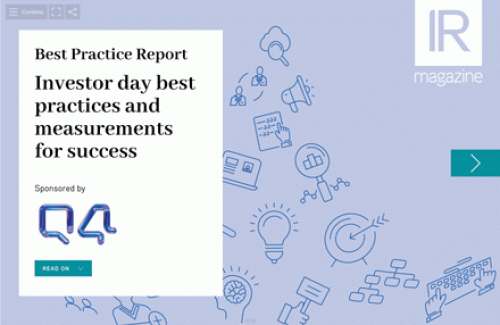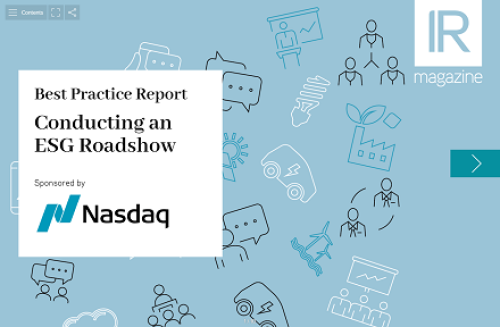At the latest IR Magazine Webinar, held in partnership with Notified, panelists addressed challenges facing IROs when planning an investor day in 2023 and shared top tips on how to overcome those obstacles.
New challenges in the IR space include macroeconomic volatility, an increasingly busy analyst and investor community, emergence from a virtual environment and growth in retail investors. We summarize six takeaways on how to tackle those hurdles to maximize your company’s reach during your investor day and deliver effective compelling messages to your shareholders.
1. Structure to deliver a long-term picture
The goal of most companies at investor days is to deliver a long-term view of the business to new and existing shareholders. For Debbie Hancock, vice president of IR at Hasbro, the first step for companies in effectively communicating a long-term picture is to ensure the timing of the event is right. ‘If you hold it at the wrong time of the year, you can easily get distracted by some short-term event that’s happening at your company, in your industry [or] in the market in general,’ she said.

She also pointed out that even before starting to plan the event, companies should sit back and decide what they want to achieve: ‘[It’s important] to understand your objectives for your events. What are the messages you want to deliver? If you’re setting a multi-year plan, how does everything you’re talking about tie into that?’
While it is not unusual for short-term issues to also get addressed at an investor day, Hancock said it’s best practice to talk about those later in the day.
2. Producing and delivering
Once a company has successfully assessed the message it wants to convey, it’s time to plan how to ensure it is understood. ‘Think through what elements of the investor day are going to emphasize the messaging you want to achieve’, said David Calusdian, president of Sharon Merrill. Whether it’s a customer panel, a virtual tour of a company’s facility, in-person demonstrations or a virtual tour, IROs need to think beyond just a PowerPoint presentation, he added.

Calusdian said slides are still relevant but argued it’s not necessarily the first tool IROs should use to outline a strategy. ‘You get to the PowerPoint decks to emphasize the messaging,’ he explained. ‘When you do [get to it], be really message-focused and resist the urge to say too much – especially resist the urge to say too much on any one slide because then your message gets lost and nothing gets through. Use crisp, clean slides and mix those up with a lot of different types of elements.’
3. Choose the location that best fits your business
Picking a location for an investor day is not exactly a no-brainer. Whether it’s at company headquarters, a plant site, a stock exchange or a public venue, each option may come with advantages and disadvantages. And beyond the type of venue, it’s important to be mindful of its geographical location.
For Mark Macaluso, vice president of IR and global communications at manufacturing company ITT, there are obvious advantages to picking a plant site, for example. ‘Seeing where all this stuff gets made is critically important, and meeting some of the folks on the ground [is beneficial],’ he said. Macaluso also pointed out that location accessibility and availability of audiovisual systems on site are important factors to consider.
4. Don’t have a tangible product? Put your thinking cap on
For companies without a tangible product to showcase, it’s important to get even more creative to ensure investors stay engaged at the event. Calusdian said it’s important for those companies to think outside the box.

‘Get creative,’ he suggested. ‘Look at different ways you can use video and other digital elements to emphasize your message, whether it’s a virtual tour, video interviews with customers, partners or something else. You can use video or animation to get the point across in a more graphical way: a picture is worth 1,000 words.’
5. Maximize the effectiveness of a hybrid format
People nowadays are more used to tapping elbows onto their desks than shaking hands and it’s easy to get distracted when attending meetings virtually. So how can companies ensure that at their hybrid event, virtual attendees stay as engaged as the ones on-site? Sharing her experience gained at Hasbro’s hybrid investor days, Hancock said her company leveraged the video element: ‘We use a lot of videos as it’s part of our business. All of them had a moderator who navigated those conversations.’ She added that best practice is to keep presentations concise.
6. Measuring the success of your investor day
For Calusdian there are two simple ways to assess attendee satisfaction. ‘One is through a post-event survey or full perception study on it to see whether your message resonated with the audience,’ he said. ‘Another simple way is to look at analyst headlines.’
He urged companies to think about those analysts’ headlines while planning the event and then work their way backwards. ‘The next day [analysts] will pull together key takeaways from your event and, by looking at those notes, you will know whether they reflect your messaging,’ he concluded.










